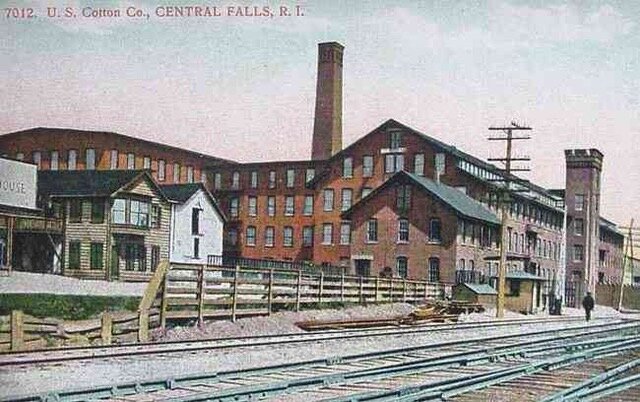William Morgan: Some big proposals for tiny Central Falls
There seem to be four facts about Rhode Island's smallest city that most people know: smallness, density, ethnic mix, and that Viola Davis grew up here.
With 20,000 people squeezed into 1.29 square miles – seven times larger than Vatican City and almost as big as the principality of Monaco – Central Falls is one of the densest municipalities in the country.
Broad Street, Central Falls, 1908.
Central Falls is also one of the most diverse communities anywhere, which is saying a lot for Rhode Island. The Irish came to build the Providence and Worcester Railroad in the mid 19th Century, while Rhode Island's first Francophone church (1875) speaks of the influx of French-Canadians who came to work in the mills. And now the almost-half Latinx population comes from every Spanish-speaking country in the hemisphere.
The Coptic pope may make Cranston his first American stop, and the president of Colombia came to Central Falls on his last visit to the United States. On Roosevelt Boulevard, there is a Salvadoran restaurant next to a Polish club.
As for the first Black actress to win an Academy Award, a Tony and an Emmy, Viola Davis was twice named to Time Magazine's 100 most influential people in the world. But as she told Harper's Bazaar after she got her Oscar, she had a childhood of "abject poverty, living in condemned, rat-infested apartments."
U.S. Cotton Company (also called United States Flax Company), 1863 ff. This was the first factory to be oriented to the railroad instead of the Blackstone River, which first powered the area’s mills.
Central Falls, now a down-at-the heels place, was once an industrial powerhouse, but its cocaine habit gave it the nickname Sparkle City in the 1980s. It simply never recovered from the collapse of the Rhode Island textile industry, in the 1920s. Central Falls's motto, “A City with a Bright Future,’’ seems painfully ironic.
Clearly, a struggling Central Falls, not too long out of receivership, is not East Greenwich, Barrington or Providence's East Side. Yet it deserves better than a reputation of corruption and hopelessness.
Central Falls has a long history. In 1676, during King Philip's War, Narragansett sachem Canonchet massacred a group of Plymouth Colony soldiers there. But mostly it is known as a classic New England mill town along the swift-moving Blackstone River; eight factories were making cloth and thread there by 1825, joining an earlier chocolate factory, laying the foundation for many decades of boom.
Central Falls Woolen Mill, 1870 (left); Pawtucket Hair Cloth Mill 1864 right).
— Photo by William Morgan
Central Falls has some magnificent mills. Recent transformation of some of them into housing is a positive development. When the MBTA's Central Falls/Pawtucket railroad stop reopens, apartments in renovated textile factories ought to be especially appealing to Bostonians looking for cheaper but capacious housing.
Abandoned Central Falls/Pawtucket railroad station, c1911. The proposed new train stop will only have a platform, as there are no plans to restore this magnificent temple of transport.
—Photo by William Morgan
One can imagine tours of Central Falls that would appeal to historians of architecture, engineering, labor relations, immigration and the textile industry. But that alone will hardly turn the city's fortunes around.
How about some immodest proposals to make all of Central Falls a national laboratory for the study of architecture and urban design, and much more?
On a Blackstone River bridge built by the Works Progress Administration
— Photo by William Morgan
This New Deal-like project could attract national corporations, foundations and think tanks, but let's begin with Rhode Island colleges and universities. (Ideally, the state should be involved, but it is doubtful that it has the resources or the inclination to invest much more in Central Falls.)
Possible avenues of support and study might include:
- Brown to study and teach languages and government.
- RISD, perhaps in concert with MIT and Harvard, to work on planning and design issues.
- The education school at Rhode Island College to work on improving the schools, joining the nationally recognized Learning Community already in place.
- URI engineering to explore how to revive the mills – to manufacture goods, attract technology and provide employment.
- Johnson and Wales to expand upon and encourage the diverse ethnic cuisines (and perhaps revive the chocolate factory). Their hospitality program could create B and B's with a genuine triple-decker experience.
And consider tiny Monaco, with its grand prix races. So how about a road race–maybe vintage cars overseen by New England Tech–along the Blackstone from Roosevelt Boulevard to Valley Falls Pond.
Given its density and smallness, Central Falls could become a model cooperative experiment, showing the region and the nation how to create an urban renaissance in a post-pandemic world.
A factory that speaks of Central Falls’s legacy of industrial prowess
—Photo by William Morgan
Providence-based architectural writer William Morgan has a degree in the restoration and preservation of historic architecture from Columbia University. He’s the author of many books.





